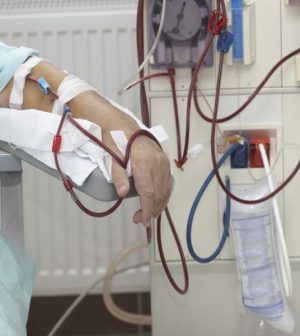- Understanding the Connection Between Anxiety and Depression
- How Daily Prunes Can Influence Cholesterol and Inflammation
- When to Take B12 for Better Absorption and Energy
- Epsom Salts: Health Benefits and Uses
- See What Saffron Can Do for Sleep and Heart Health
- 6 Common Mistakes to Avoid Before Your Physical
- Can Sweating Really Help You Beat a Cold?
- Strengthening Your Relationship: Practical Strategies
- Skip Storing This Everyday Product in the Fridge Door
- Green Tea + B3 Pairing May Boost Brain Health
Catheters Often to Blame for Blood Infections After Dialysis

Tubes called catheters that are used to draw and return blood to the body during dialysis appear to cause the majority of bloodstream infections in people receiving dialysis for kidney problems, a new study finds.
Three-quarters of bloodstream infections in dialysis patients were related to accessing their blood, the 2014 U.S. Centers for Disease Control and Prevention data showed.
The information came from more than 6,000 outpatient dialysis centers in 2014. There were nearly 30,000 bloodstream infections reported, the study found.
The analysis also found that 63 percent of all bloodstream infections and 70 percent of access-related bloodstream infections occurred in patients with a central venous catheter — also called a central line. Other dialysis complication rates were also highest among patients using central venous catheters, the findings showed.
Staphylococcus aureus was the most common bacterial cause of bloodstream infections (31 percent). Forty percent of the S. aureus samples were resistant to the antibiotic methicillin (“MRSA”), the investigators found.
Dialysis patients have an increased risk for infection due to the repeated need to access their blood, the study authors explained.
“Our findings emphasize the need for hemodialysis facilities to improve infection prevention and vascular access care practices,” study author Dr. Duc Bui Nguyen, from the CDC, said in a news release from the American Society of Nephrology.
The study authors said there are other options available for dialysis patients, such as an arteriovenous fistula. This is created by connecting a patient’s own vein and artery to form a long-lasting site through which blood can be removed and returned.
Another option is an arteriovenous graft, which is a plastic conduit between an artery and a vein, the researchers said.
Findings from the study were published June 29 in the Clinical Journal of the American Society of Nephrology.
In an editorial accompanying the study, Dr. Dana Miskulin of Tufts University School of Medicine and Dr. Ambreen Gul of Dialysis Clinic, Inc., explained that part of the problem may be that dialysis units have been placed on an “honor system” when it comes to reporting adverse events.
The editorialists “make a plea to the dialysis community to ‘clean up’ the data, so that the quality incentive program is fairer for all, and to enable the full potential of these data … to be realized.”
More information
The U.S. National Institute of Diabetes and Digestive and Kidney Diseases has more on dialysis.
Source: HealthDay
Copyright © 2026 HealthDay. All rights reserved.










